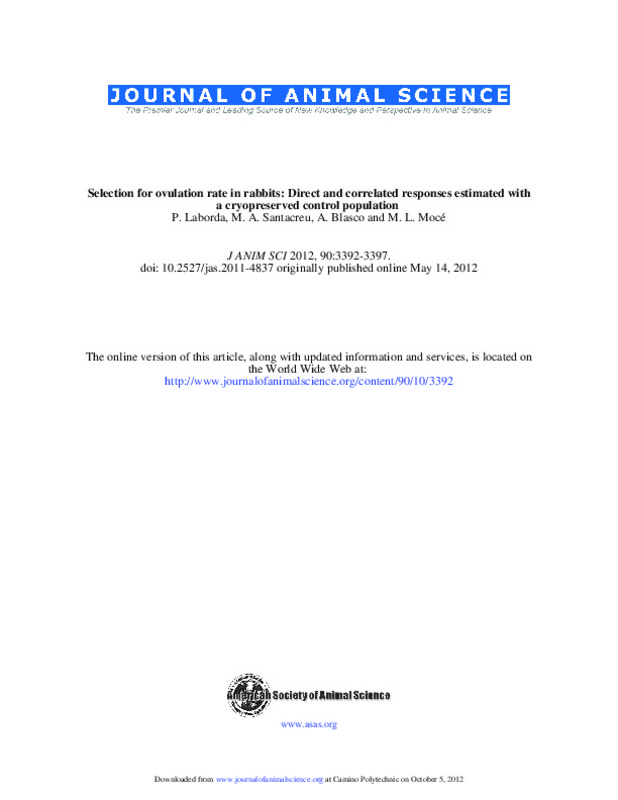JavaScript is disabled for your browser. Some features of this site may not work without it.
Buscar en RiuNet
Listar
Mi cuenta
Estadísticas
Ayuda RiuNet
Admin. UPV
Selection for ovulation rate in rabbits: Direct and correlated responses estimated with a cryopreserved control population1
Mostrar el registro sencillo del ítem
Ficheros en el ítem
| dc.contributor.author | Laborda Vidal, Patricia
|
es_ES |
| dc.contributor.author | Santacreu Jerez, María Antonia
|
es_ES |
| dc.contributor.author | Blasco Mateu, Agustín
|
es_ES |
| dc.contributor.author | Mocé Cervera, María Lorena
|
es_ES |
| dc.date.accessioned | 2017-03-07T12:09:27Z | |
| dc.date.available | 2017-03-07T12:09:27Z | |
| dc.date.issued | 2015-01-20 | |
| dc.identifier.issn | 0021-8812 | |
| dc.identifier.uri | http://hdl.handle.net/10251/78546 | |
| dc.description.abstract | The aim of this work was to evaluate the response in 10 generations of selection for ovulation rate in rabbits using a cryopreserved control population. Selection was based on the phenotypic value of ovulation rate estimated at d 12 of second gestation by laparoscopy. To produce the control population, embryos from 50 donor females and 18 males, belonging to the base generation of the line selected for ovulation rate, were recovered. A total of 467 embryos (72-h embryos) were vitrifi ed and stored in liquid N2 for 10 generations. The size of both populations was approximately 10 males and 50 females. The number of records used to analyze the different traits ranged from 99 to 340. Data were analyzed using Bayesian methodology. A difference between the selected and the control populations of 2.1 ova (highest posterior density interval (HPD95%) [1.3, 2.9]) was observed in ovulation rate (OR), but it was not accompanied by a correlated response in litter size (LS; −0.3; HPD95% [−1.1, 0.5]). The number of implanted embryos (IE) increased with selection in 1.0 embryo (HPD95% [−0.6, 2.0]), but this increase was not relevant. Prenatal survival, embryonic survival, and fetal survival (FS) were calculated as LS/OR, IE/OR, and LS/IE, respectively. Prenatal survival was reduced with selection (−0.12; HPD95% [−0.20, −0.04]), basically because of a decrease in FS (−0.12; HPD95% [−0.19, −0.06]). Embryonic survival could have slightly decreased (−0.05; HPD95% [−0.12, 0.02]). In summary, comparison with a control population showed that ovulation rate in rabbits increased with selection without any correlated response in litter size, basically because of a decrease in fetal survival. | es_ES |
| dc.description.sponsorship | This study was supported by the Comision Interministerial de Ciencia y Tecnologia CICYT-AGL2005-07624-C03-01 and by funds from the Generalitat Valenciana research program (Prometeo 2009/125). The authors are grateful to Wagdy Mekkawy for letting us use his programs. | en_EN |
| dc.language | Inglés | es_ES |
| dc.publisher | American Society of Animal Science | es_ES |
| dc.relation.ispartof | Journal of Animal Science | es_ES |
| dc.rights | Reserva de todos los derechos | es_ES |
| dc.subject | Cryopreserved control population | es_ES |
| dc.subject | Fetal survival | es_ES |
| dc.subject | Litter size | es_ES |
| dc.subject | Ovulation rate | es_ES |
| dc.subject | Rabbit | es_ES |
| dc.subject | Selection | es_ES |
| dc.subject.classification | PRODUCCION ANIMAL | es_ES |
| dc.title | Selection for ovulation rate in rabbits: Direct and correlated responses estimated with a cryopreserved control population1 | es_ES |
| dc.type | Artículo | es_ES |
| dc.identifier.doi | 10.2527/jas.2011-4837 | |
| dc.relation.projectID | info:eu-repo/grantAgreement/MEC//AGL2005-07624-C03-01/ | es_ES |
| dc.relation.projectID | info:eu-repo/grantAgreement/GVA//PROMETEO%2F2009%2F125/ES/Efecto de la crioconservación de embriones sobre el desarrollo y el re-establecimiento de poblaciones/ | es_ES |
| dc.rights.accessRights | Abierto | es_ES |
| dc.contributor.affiliation | Universitat Politècnica de València. Instituto de Ciencia y Tecnología Animal - Institut de Ciència i Tecnologia Animal | es_ES |
| dc.contributor.affiliation | Universitat Politècnica de València. Escuela Técnica Superior de Ingeniería Agronómica y del Medio Natural - Escola Tècnica Superior d'Enginyeria Agronòmica i del Medi Natural | es_ES |
| dc.description.bibliographicCitation | Laborda Vidal, P.; Santacreu Jerez, MA.; Blasco Mateu, A.; Mocé Cervera, ML. (2015). Selection for ovulation rate in rabbits: Direct and correlated responses estimated with a cryopreserved control population1. Journal of Animal Science. 90(10):3392-3397. https://doi.org/10.2527/jas.2011-4837 | es_ES |
| dc.description.accrualMethod | S | es_ES |
| dc.relation.publisherversion | http://dx.doi.org/10.2527/jas.2011-4837 | es_ES |
| dc.description.upvformatpinicio | 3392 | es_ES |
| dc.description.upvformatpfin | 3397 | es_ES |
| dc.type.version | info:eu-repo/semantics/publishedVersion | es_ES |
| dc.description.volume | 90 | es_ES |
| dc.description.issue | 10 | es_ES |
| dc.relation.senia | 239944 | es_ES |
| dc.contributor.funder | Generalitat Valenciana | es_ES |
| dc.contributor.funder | Ministerio de Educación y Ciencia | es_ES |








